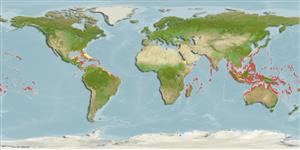Common names from other countries
Environment: milieu / climate zone / depth range / distribution range
экология
; пределы глубины 0 - 20 m (Ref. 4). Tropical; 33°N - 36°S, 97°W - 135°W (Ref. 4)
Indo-Pacific and Western Atlantic.
Length at first maturity / Size / Вес / Возраст
Maturity: Lm ? range ? - ? cm Max length : 20.0 cm TL самец/пол неопределен; (Ref. 4)
It has lengths of 20 cm, maximum total length; between 2 and 9, carapace length (Ref. 4). Taken at depths from 0 to 20 m, in coral or stone reefs with a sandy bottom. It is nocturnal and in the daytime hides in crevices, sometimes in small groups (Ref. 4). Also on rubble (Ref. 97531). Scyllarids are commonly considered to be opportunistic omnivorous (Ref. 106411). Aquarium observations indicate that they may open bivalves (Ref. 102680).
Life cycle and mating behavior
половая зрелость | размножение | нерест | икра | Fecundity | личинки
Members of the order Decapoda are mostly gonochoric. Mating behavior: Precopulatory courtship ritual is common (through olfactory and tactile cues); usually indirect sperm transfer.
Основная ссылка
ссылки | координатор | соавторы
Holthuis, L.B. 1991. (Ref. 4)
Статус Красного Списка МСОП (Ref. 130435)
Статус СИТЕС (Ref. 108899)
Not Evaluated
Not Evaluated
Использование человеком
рыболовство: коммерческий
| FishSource | Sea Around Us
инструменты
дополнительная информация
Возраст/Размеры
рост
Зависимость между длиной и массой тела
Зависимость между длинами
морфология
личинки
численность
ресурсы в Интернет
Estimates based on models
Preferred temperature
(Ref.
115969): 25.6 - 29.3, mean 28.1 (based on 3695 cells).
Уязвимость
Low vulnerability (10 of 100).
